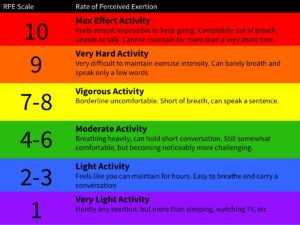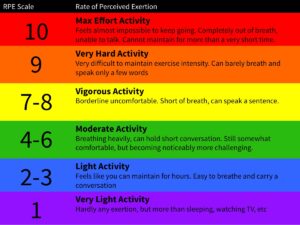Interval Training Ride: Your focus for these rides is to increase your strength, power and endurance by tapping into Zones 3, 4 and 5. You will be combining challenging efforts that are at 80%-100% of your max effort with short periods of recovery at varying cadence (to simulate flat and hilly terrain).
Aerobic training rides: Your focus for these rides is to build up your aerobic base, meaning that you’ll be spending the majority of your time “within your comfort zone” at an effort where you are not out of breath. The goal is to increase your endurance so that you can maintain a higher effort for longer periods of time. Recoveries should feel light to moderate.
Single leg drill: For beginners, we recommend doing this drill with both feet attached to the pedals. For ~30 seconds, pedal with about 80% of your effort coming from 1 leg (and only about ~20% of your effort from your other leg). After 30 seconds, switch legs. It should feel like 1 leg is doing all the work and the other is going along for a free ride. This helps create uniform pedal strokes by forcing you to pedal “full circle” (instead of just pushing down and “mashing” on the pedals).
Spin ups: An interval where your cadence increases to 100-110 rpms and you’re pedaling as fast as you can without bouncing in the saddle. Good for increasing leg turnover speed (which helps your muscles warm up and helps transition to a fast run off the bike)
Rpm:Revolutions per minute (90rpm = 90 revolutions per minute). This is the number of times your foot rotates in a full circle per minute. If you don’t have a bike computer, this can be calculated by counting how many times 1 leg reaches the bottom of the pedal stroke for 15s and multiply that number by 4.
Cadence (pedaling rate): The number of revolutions per minute. Cadence is measured in RPMs. If you’re pedaling at 90rpm’s, your cadence is 90.
Zone Training: Refers to the process of exercising in different intensityzones during cardiorespiratory training. Itestablishes optimal exercise intensities based on your unique metabolism, heart rate, current level of fitness, and health or fitness goals. Common ways to determine what zone you’re exercising in include Heart Rate, Power, and Rate of Perceived Effort. There are 5 commonly known zones (Z1 – Z5), with Z1 being the “easiest” and Z5 being the “hardest”. Effort can be measured in a number of different ways including RPE (rated perceived exertion), HR (% of max heart rate), or Power (measured in Watts by using a power meter). To further help explain:
“¢ Zone 1. RECOVERY. Intensity: 40-50% of your max. Effort is easy and you can easily breathe and maintain a conversation. You could go at this pace all day. Zone 1 = RPE 1-3
“¢ Zone 2. ENDURANCE TRAINING. Intensity: 50-60% of your max. Effort is moderate. Your heart rate is up a touch, but you can still talk and maintain this effort for over an hour. Zone 2 = RPE 4-6
“¢ Zone 3. AEROBIC CAPACITY (TEMPO) Intensity: 70-80% of your max. Effort is moderate/hard. You can talk in fragmented sentences but are breathing a bit harder. Zone 3 = RPE 7-8
“¢ Zone 4. LACTATE THRESHOLD. Intensity: 80-90% of your max. Effort is HARD and outside of your comfort zone. Challenging to speak. Zone 4 = RPE 9
“¢ Zone 5. VO2. Intensity: 90-100% Max. ALL OUT. You’re working at your max. An effort you can maintain for a very short period. You DEFINITELY need a break after a Z5 effort. Zone 5 = RPE 10
Looking for a bike trainer? Check out Bicycling Magazines review of the top indoor bike trainers.
Smart Trainer: Atool you mount your bike on that offers resistance like a normal trainer, but with the added benefit of allowing the resistance to be controlled by cycling apps such as Zwift, Trainer Road and Rouvy.
Cycling apps & virtual training systems:
Zwift: is a massively multiplayer online cycling and running videogame and physical training program that enables users to interact, train and compete in a virtual world.
Rouvy: An app that turns your cycling routine into a fun adventurewith realistic road feel and simulation. Ride 1500+ high-quality video routes from the most beautiful places in the world! Rouvy allows you to compete in a race or train alone.
Trainer Road: Power-based indoor and outdoor workouts, training plans and cycling analytics.





